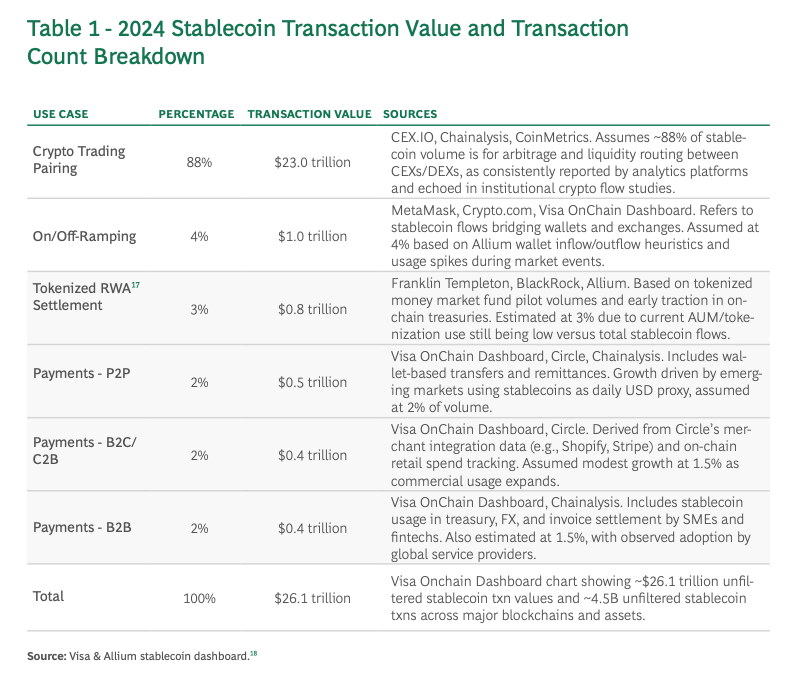Institutional Stablecoin Adoption, Quantified: BCG, OCBC & Standard Chartered Cite Allium’s Data
Over the past few months, three widely read institutional reports—by Boston Consulting Group (BCG), OCBC Global Markets Research, and Standard Chartered—have leaned on Visa On-Chain Analytics powered by Allium to separate signal from noise in stablecoin activity. The result is a clearer view of where stablecoins are actually used today (beyond exchange arbitrage) and how policy, risk, and infrastructure are evolving.
1) BCG — Stablecoins: Five Killer Tests to Gauge Their Potential (May 2025)
What they ask: Do stablecoins add incremental value versus existing money rails—and where?
How Allium appears: BCG uses Visa On-Chain Analytics (powered by Allium) for adjusted on-chain volumes and methodology, and notes discussions with Allium to understand categorization and approach.
Notable takeaways
- Unfiltered vs. adjusted volumes: BCG references ~$26.1T in 2024 stablecoin transaction value before filtering out internal flows, trading, bots, and on/off-ramp noise. After categorization, they estimate ~8% tied to real-world payments and tokenized asset settlement—still material at multi-trillion dollar scale under their approach.
- Use-case lens: They frame adoption through “five killer tests” (speed, cost, traceability, automation, coexistence with CBDC/TDs), concluding near-term value is corridor- and use-case-specific, while programmability and cross-border advantages widen over time.
- Institutionalization: The paper underscores rising bank and PSP engagement (reserves, custody, cross-border payouts, treasury), with stablecoins increasingly part of mainstream experiments and pilots.

2) OCBC — Stablecoins: Unpacking the Future of Digital Currency (July 2025)
What they ask: How big is stablecoin usage by function, where are the risks, and what do new rules mean?
How Allium appears: OCBC cites Visa–Allium for adjusted 2024 transaction volume (~$5.5T) after removing high-frequency trading, bots, and internal transfers. They compare that to traditional networks for context.
Notable takeaways
- Scale & methodology: While some reports cite >$26T unfiltered 2024 volume, OCBC highlights ~$5.5T adjusted via Visa–Allium to represent real-economy activity (payments, remittances, commerce) more faithfully.
- Comparative context: They note Visa processed ~$14T and PayPal ~$1.68T in 2024 TPV—positioning adjusted stablecoin volumes as still smaller than the biggest card networks but increasingly relevant, especially cross-border.
- Risk & regulation: The report surveys design trade-offs (fiat-backed vs crypto-collateralized vs algorithmic), concentration risk, run/de-peg risk, and digital dollarization concerns in EMs. It also summarizes regulatory momentum (e.g., MiCA in the EU; evolving US frameworks; HK and Singapore regimes).

3) Standard Chartered & Zodia Markets — Stablecoins: The First Killer App (2025)
What they ask: What’s driving structural, non-exchange usage—and how does ‘on-chain FX’ and T+1 settlement fit?
How Allium appears: The report’s use-case charts cite Visa On-Chain Analytics (powered by Allium), showing ‘other’ (non-CEX) activity growing into a large share of transactions.
Notable takeaways
- From trading to TradFi: The analysis shows non-exchange (“other”) uses—like USD savings, remittances, merchant payments, and settlement—now constitute a substantial share of activity, indicating a structural shift beyond crypto trading cycles.
- Operational edge: Case studies illustrate how 24/7 settlement and programmability can ease T+1 frictions and enable on-chain PvP FX between fiat-referenced tokens (e.g., USDC/AUDD).
- Network reality: They stress that advantages are greatest where correspondent banking is thin and cross-border frictions are highest.

Related Articles
Stay Updated with Our Blog
Get the latest blog updates directly to your inbox.






